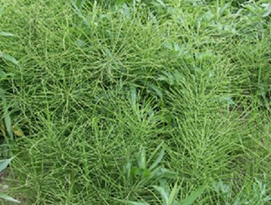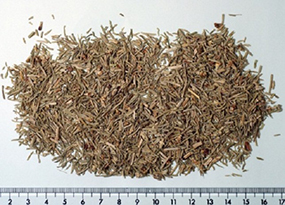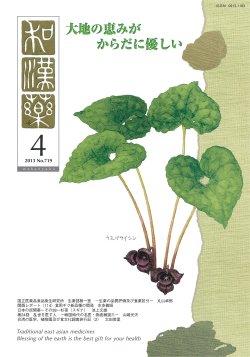|
| |||||||||||||||||||
|
Origin Equiseti herba (sugina in Japanese) is derived from the dried stems (sterile stems) or entire plant of Equisetum arvense L., which belongs to the Equisetaceae family. This perennial green summer fern is widely distributed in temperate regions of the northern hemisphere and is often found in fields, mountains, wetlands, and along the roadside. It grows abundantly in summer with the help of its long horizontal underground rhizomatous stem, which is black or dark brown in color; and the rhizomatous stem survive in the soil throughout the winter. In spring, epigeal stems arise from the nodes of the rhizome. These stems can be divided into two types. The first type is sterile stems (sugina), which measure 30-40 cm in height and are hollow and cylindrical. Side shoots arranged in whorls grow from the nodes of these stems, and their degenerated leaves are small and scale-like in shape. The other type of stem is fertile spore-bearing stems called tsukushi (土筆). These develop in early spring and are fleshy and purple to brown in color. A long elliptical sporangium spike, which is pale yellow-green in color, grows on top of each of these stems. The E. arvense plant is also known as the horsetail and monkei (問荊) in the West and Kampo medicine, respectively. History The scientific name of the plant, Equisetum, is derived from the Latin words “equus” (meaning horse) and “saeta” (meaning stinger), while “arvense” means “lives in wilderness”. The English name “horsetail” is derived from its scientific name, which can be roughly translated as "the tail of a horse". Meanwhile, the Japanese name sugina (杉菜) came from the fact that the plant looks like a Japanese cedar tree. Incidentally, tsukushi is considered to be derived from the word miotsukushi (澪標) because tsukushi looks like the poles that are used to mark harbor entrances. However, there are several other possible origins of the word tsukushi (土筆), e.g., the top of the tsukushi looks like a brush so it is sometimes referred to as a brush stuck in the soil. Alternatively, it might be derived from the word tsukuko (付く子: the character子can be pronounced as ko or shi), which adheres to sugina. Tsukushi has traditionally been eaten as hitashimono (boiled green vegetables seasoned with soy sauce), and sugina was also used in cookery in the Edo era. In addition, Hayato Fukuba is said to have successfully cultivated tsukushi in the Shinjuku Gyoen belonging to the Ministry of the Imperial Household in the mid-Meiji era. However, eating too much tsukushi is considered to be dangerous because of the alkaloids it contains. Compounds The E. arvense whole plant contains the following compounds: an alkaloid (palustrine), a saponin (equisetonin), flavonoids (isoquercetin, galuteolin, and equisetrin), lipids, amino acids, β-sitosterol, vitamin C, and minerals (calcium, phosphorus, magnesium, iron, copper, and silicon dioxide [also known as silica]). In addition, its epigeal stems contain vitamin B1, articulatin, isoarticulatin, gossypitrin, etc. Pharmacological effects and toxicity The alcohol-soluble components and fluid extracts of fresh whole sugina plants have mild diuretic effects; however, such effects are not induced by water decoctions of sugina. When intravenously administered to rabbits or dogs, the water decoction of sugina induced a reduction in blood pressure and stimulated reflexive respiration. This hypotensive effect was not affected by atropine, and the active components responsible for it were found to be water-soluble, but insoluble in alcohol and chloroform. In addition, a small amount of the fresh water decoction of sugina was found to enhance the contractile force of an isolated frog heart, while a large amount of the decoction inhibited its contraction. In recent years, it has been reported that silica promotes collagen synthesis and strengthens blood vessels, bones, and connective tissue by inducing collagen bundling; therefore, silica has been attracting attention as a useful material for preventing osteoporosis and maintaining the health of hair and nails and has also been suggested to have anti-aging effects on the skin. E. arvense is considered to be safe for human use as it has been used as a food or herb since ancient times. However, the long-term ingestion of sugina or its consumption in large quantities can cause vitamin B1 (thiamine) deficiency, as it possesses thiaminase-like activity. In fact, in Canada horsetail products have be certified as free from thiaminase-like activity. Also, consuming large quantities of inorganic silicon can cause various conditions, e.g., fever, ‘coldness’ in the limbs, and movement disorders. So, the long-term ingestion of sugina or feeding it to children might be dangerous. In addition, when sugina is taken together with diuretics, e.g., acetazolamide or furosemide, or antihypertensive drugs, e.g., methyldopa, drug interactions with markedly negative effects can arise. Therefore, sugina is contraindicated for patients with heart or kidney problems. Moreover, it is also contraindicated for pregnant and lactating women, people who are allergic or hypersensitive to sugina and its related substances, and those who are allergic to nicotine. Furthermore, sugina should not be taken in large quantities as it can cause diarrhea or vomiting. In addition, when sugina is used together with irritating purgative herbs, e.g., aloe or senna, the risk of calcium loss might be increased. Medicinal effects, dosage, and administration In the ‘Bencaoshiyi (本草拾遺)’, sugina was described as being neutral in nature, bitter in flavor, and non-toxic. As for its effects, it is considered to be a heat-clearing antitussive and diuretic. It is used to treat epistaxis, hematochezia, menorrhagia, hemorrhoids, cough, asthma, and conditions affecting the urinary system. Japanese folks, sugina is known as a diuretic, antitussive, antipyretic, hemostatic, and eliminating roundworms medicine. Therefore, it is used to treat gonorrhea, cystitis, edema, bronchitis and bleeding hemorrhoids. When it is used as a diuretic, antitussive, or antipyretic medicine, 5~10 g of the herb are placed into 300 ml water and boiled until the volume of the decoction is reduced to approximately 100 ml. The resultant decoction is consumed 3 times a day. The indications for this decoction include prostatitis, cystitis, urethritis, metrorrhagia, lightless of the nails or hair, internal bleeding due to diabetes (diabetic retinopathy), and enuresis. For urinary tract disease, Japanese honeysuckle (the leaves and stems of suikazura) or Java tea (nekonohige leaves) is added to half a dose of sugina, whereas to treat poor circulation half a dose of ginkgo (icho leaves) or hawthorn (the fruits of sanzashi) is added to sugina. As for external use, a poultice of sugina can stop wound bleeding, and sugina can also be added to bath water to relieve menstrual pain. Moreover, washing with a decoction of sugina or applying its raw juice can help to cure lacquer poisoning. In addition, the consumption of well-boiled sugina can eliminate roundworms. In Western countries, horsetail (sugina) is considered to be a medicinal plant with hemostatic and diuretic effects and is used to treat the following conditions: pulmonary tuberculosis, infections or stones in the urinary tract, prostatomegaly, enuresis, dysmenorrhea or metrorrhagia, stomach ulcers, and anemia, etc. Regarding external use, it is applied to injuries, burns, and regions of eczema, etc. In addition, it is also utilized in shampoo or cosmetics. Others Sugina products composed of green plant material without roots or other impurities are considered to be of good quality and should be stored in an airtight container after being fully dried in order to prevent contamination. Sugina products should be kept in a dark airy space, and care should be taken prevent them from becoming moist or being eaten by worms. Sugina, which is a primitive plant, is considered to be a descendant of the large woody plants that existed in the Paleozoic era (600 million to 375 million years ago), while the fertile stems of tsukushi have been popular wild spring vegetables since ancient times. Although most of the folk medicines introduced into Japan came from China, sugina came from the West and the medicinal effects are considered to have been introduced into Japan during trading with the Netherlands and Portugal in the Edo era. In 17th century England, fresh horsetail juice or decoctions were used to achieve hemostasis and relieve the pain associated with urodynia, which is caused by calculi, urolithiasis, or cystitis. In Germany, horsetail was taken orally to cure injury-induced edema, and it was also used to treat infections of the urinary system; i.e., cystitis and urethritis, and kidney or urinary tract stones. In addition, in Ayurvedic medicine the herb is used to treat prostatomegaly, incontinence, and enuresis. Silica (silicon dioxide) is the second most abundant element in the biosphere after oxygen, and it is often found as quartz. When some of the quartz dissolves, it can be taken up by plants, in which it exists as silica and silicates. Silica is important for maintaining plant connective tissue, as it can be used to strengthen and repair it. In addition, it enhances its regenerative capacity and increases its elasticity. When it comes to silica, most people tend to think of silica gel. However, unlike the silica taken in by plants, quartz silica gel cannot be directly absorbed by the human body. Sugina is sometimes included in tempura and herbal tea and is used as a bath herb to ease the inflammation and itching caused by heat rash or eczema. Moreover, it is also utilized in wreaths and potpourri. Cultivation and collect of sugina Sugina is considered to be a frontier plant and can grow in quite acidic soil. Accordingly, it is one of the earliest plants to emerge from wasteland; however, it gradually disappears as the quality of the soil improves. The aerial parts of the plant are collected, washed in water, and then dried in the shade, and the optimal time to collect it is from May to July. Reference Ikegami F., Wakanyaku, 719, 5-6, (2013.4) |
 |
 |
| Equisetum arvense L | Equiseti Herba |
Top / Company Profile / Company History / Japanese Folk Medicine
